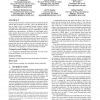Free Online Productivity Tools
i2Speak
i2Symbol
i2OCR
iTex2Img
iWeb2Print
iWeb2Shot
i2Type
iPdf2Split
iPdf2Merge
i2Bopomofo
i2Arabic
i2Style
i2Image
i2PDF
iLatex2Rtf
Sci2ools
SIGMETRICS
2009
ACM
2009
ACM
On the treeness of internet latency and bandwidth
Existing empirical studies of Internet structure and path properties indicate that the Internet is tree-like. This work quantifies the degree to which at least two important Internet measures—latency and bandwidth—approximate tree metrics. We evaluate our ability to model end-to-end measures using tree embeddings by actually building tree representations. In addition to being simple and intuitive models, these trees provide a range of commonly-required functionality beyond serving as an analytical tool. The contributions of our study are twofold. First, we investigate the ability to portray the inherent hierarchical structure of the Internet using the most pure and compact topology, trees. Second, we evaluate the ability of our compact representation to facilitate many natural tasks, such as the selection of servers with short latency or high bandwidth from a client. Experiments show that these tasks can be done with high degree of success and modest overhead. Categories and Subj...
| Added | 28 May 2010 |
| Updated | 28 May 2010 |
| Type | Conference |
| Year | 2009 |
| Where | SIGMETRICS |
| Authors | Venugopalan Ramasubramanian, Dahlia Malkhi, Fabian Kuhn, Mahesh Balakrishnan, Archit Gupta, Aditya Akella |
Comments (0)

